Jong-Seok Lee
Exploring Cross-Stage Adversarial Transferability in Class-Incremental Continual Learning
Aug 12, 2025Abstract:Class-incremental continual learning addresses catastrophic forgetting by enabling classification models to preserve knowledge of previously learned classes while acquiring new ones. However, the vulnerability of the models against adversarial attacks during this process has not been investigated sufficiently. In this paper, we present the first exploration of vulnerability to stage-transferred attacks, i.e., an adversarial example generated using the model in an earlier stage is used to attack the model in a later stage. Our findings reveal that continual learning methods are highly susceptible to these attacks, raising a serious security issue. We explain this phenomenon through model similarity between stages and gradual robustness degradation. Additionally, we find that existing adversarial training-based defense methods are not sufficiently effective to stage-transferred attacks. Codes are available at https://github.com/mcml-official/CSAT.
Emotional EEG Classification using Upscaled Connectivity Matrices
Feb 11, 2025Abstract:In recent studies of emotional EEG classification, connectivity matrices have been successfully employed as input to convolutional neural networks (CNNs), which can effectively consider inter-regional interaction patterns in EEG. However, we find that such an approach has a limitation that important patterns in connectivity matrices may be lost during the convolutional operations in CNNs. To resolve this issue, we propose and validate an idea to upscale the connectivity matrices to strengthen the local patterns. Experimental results demonstrate that this simple idea can significantly enhance the classification performance.
CROPS: Model-Agnostic Training-Free Framework for Safe Image Synthesis with Latent Diffusion Models
Jan 09, 2025Abstract:With advances in diffusion models, image generation has shown significant performance improvements. This raises concerns about the potential abuse of image generation, such as the creation of explicit or violent images, commonly referred to as Not Safe For Work (NSFW) content. To address this, the Stable Diffusion model includes several safety checkers to censor initial text prompts and final output images generated from the model. However, recent research has shown that these safety checkers have vulnerabilities against adversarial attacks, allowing them to generate NSFW images. In this paper, we find that these adversarial attacks are not robust to small changes in text prompts or input latents. Based on this, we propose CROPS (Circular or RandOm Prompts for Safety), a model-agnostic framework that easily defends against adversarial attacks generating NSFW images without requiring additional training. Moreover, we develop an approach that utilizes one-step diffusion models for efficient NSFW detection (CROPS-1), further reducing computational resources. We demonstrate the superiority of our method in terms of performance and applicability.
Impact of Regularization on Calibration and Robustness: from the Representation Space Perspective
Oct 05, 2024Abstract:Recent studies have shown that regularization techniques using soft labels, e.g., label smoothing, Mixup, and CutMix, not only enhance image classification accuracy but also improve model calibration and robustness against adversarial attacks. However, the underlying mechanisms of such improvements remain underexplored. In this paper, we offer a novel explanation from the perspective of the representation space (i.e., the space of the features obtained at the penultimate layer). Our investigation first reveals that the decision regions in the representation space form cone-like shapes around the origin after training regardless of the presence of regularization. However, applying regularization causes changes in the distribution of features (or representation vectors). The magnitudes of the representation vectors are reduced and subsequently the cosine similarities between the representation vectors and the class centers (minimal loss points for each class) become higher, which acts as a central mechanism inducing improved calibration and robustness. Our findings provide new insights into the characteristics of the high-dimensional representation space in relation to training and regularization using soft labels.
Network Fission Ensembles for Low-Cost Self-Ensembles
Aug 05, 2024Abstract:Recent ensemble learning methods for image classification have been shown to improve classification accuracy with low extra cost. However, they still require multiple trained models for ensemble inference, which eventually becomes a significant burden when the model size increases. In this paper, we propose a low-cost ensemble learning and inference, called Network Fission Ensembles (NFE), by converting a conventional network itself into a multi-exit structure. Starting from a given initial network, we first prune some of the weights to reduce the training burden. We then group the remaining weights into several sets and create multiple auxiliary paths using each set to construct multi-exits. We call this process Network Fission. Through this, multiple outputs can be obtained from a single network, which enables ensemble learning. Since this process simply changes the existing network structure to multi-exits without using additional networks, there is no extra computational burden for ensemble learning and inference. Moreover, by learning from multiple losses of all exits, the multi-exits improve performance via regularization, and high performance can be achieved even with increased network sparsity. With our simple yet effective method, we achieve significant improvement compared to existing ensemble methods. The code is available at https://github.com/hjdw2/NFE.
Low-Cost Self-Ensembles Based on Multi-Branch Transformation and Grouped Convolution
Aug 05, 2024Abstract:Recent advancements in low-cost ensemble learning have demonstrated improved efficiency for image classification. However, the existing low-cost ensemble methods show relatively lower accuracy compared to conventional ensemble learning. In this paper, we propose a new low-cost ensemble learning, which can simultaneously achieve high efficiency and classification performance. A CNN is transformed into a multi-branch structure without introduction of additional components, which maintains the computational complexity as that of the original single model and also enhances diversity among the branches' outputs via sufficient separation between different pathways of the branches. In addition, we propose a new strategy that applies grouped convolution in the branches with different numbers of groups in different branches, which boosts the diversity of the branches' outputs. For training, we employ knowledge distillation using the ensemble of the outputs as the teacher signal. The high diversity among the outputs enables to form a powerful teacher, enhancing the individual branch's classification performance and consequently the overall ensemble performance. Experimental results show that our method achieves state-of-the-art classification accuracy and higher uncertainty estimation performance compared to previous low-cost ensemble methods. The code is available at https://github.com/hjdw2/SEMBG.
Anomaly Score: Evaluating Generative Models and Individual Generated Images based on Complexity and Vulnerability
Dec 17, 2023Abstract:With the advancement of generative models, the assessment of generated images becomes more and more important. Previous methods measure distances between features of reference and generated images from trained vision models. In this paper, we conduct an extensive investigation into the relationship between the representation space and input space around generated images. We first propose two measures related to the presence of unnatural elements within images: complexity, which indicates how non-linear the representation space is, and vulnerability, which is related to how easily the extracted feature changes by adversarial input changes. Based on these, we introduce a new metric to evaluating image-generative models called anomaly score (AS). Moreover, we propose AS-i (anomaly score for individual images) that can effectively evaluate generated images individually. Experimental results demonstrate the validity of the proposed approach.
ViPLO: Vision Transformer based Pose-Conditioned Self-Loop Graph for Human-Object Interaction Detection
Apr 17, 2023
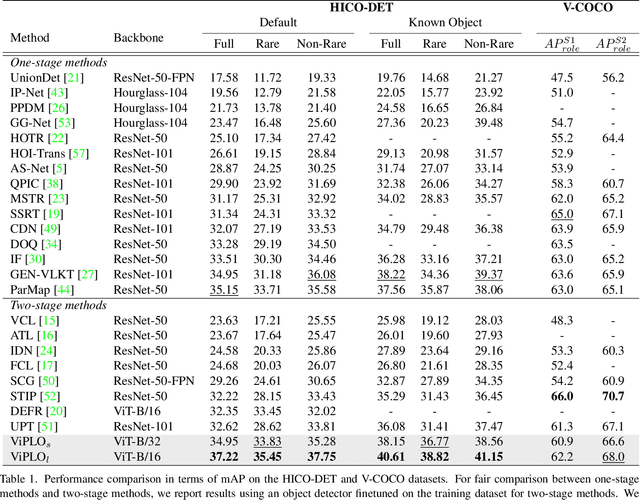
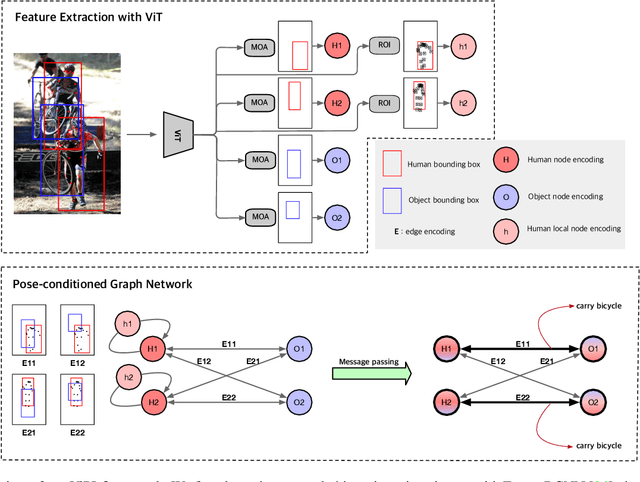
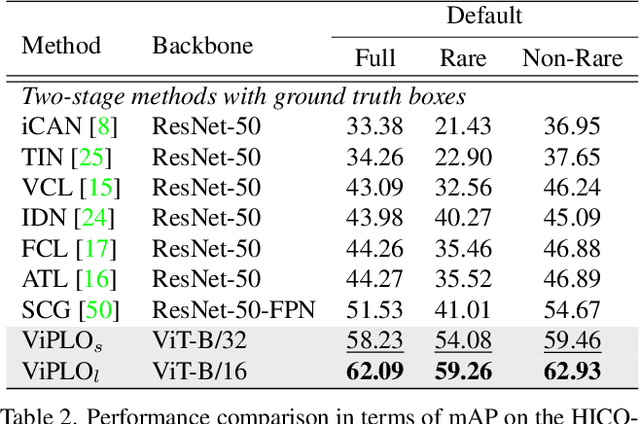
Abstract:Human-Object Interaction (HOI) detection, which localizes and infers relationships between human and objects, plays an important role in scene understanding. Although two-stage HOI detectors have advantages of high efficiency in training and inference, they suffer from lower performance than one-stage methods due to the old backbone networks and the lack of considerations for the HOI perception process of humans in the interaction classifiers. In this paper, we propose Vision Transformer based Pose-Conditioned Self-Loop Graph (ViPLO) to resolve these problems. First, we propose a novel feature extraction method suitable for the Vision Transformer backbone, called masking with overlapped area (MOA) module. The MOA module utilizes the overlapped area between each patch and the given region in the attention function, which addresses the quantization problem when using the Vision Transformer backbone. In addition, we design a graph with a pose-conditioned self-loop structure, which updates the human node encoding with local features of human joints. This allows the classifier to focus on specific human joints to effectively identify the type of interaction, which is motivated by the human perception process for HOI. As a result, ViPLO achieves the state-of-the-art results on two public benchmarks, especially obtaining a +2.07 mAP performance gain on the HICO-DET dataset. The source codes are available at https://github.com/Jeeseung-Park/ViPLO.
Similarity of Neural Architectures Based on Input Gradient Transferability
Oct 20, 2022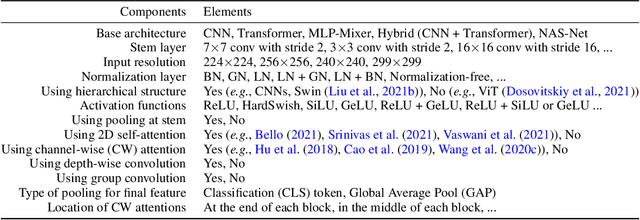
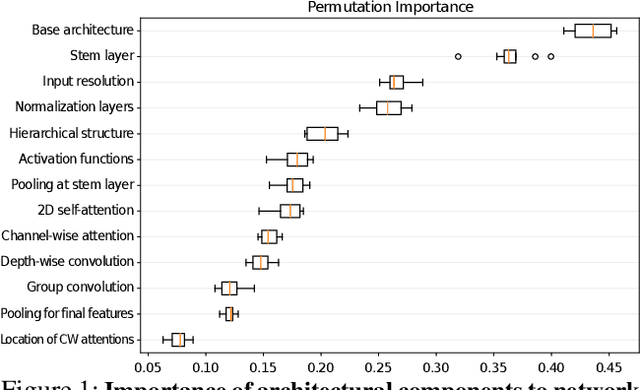
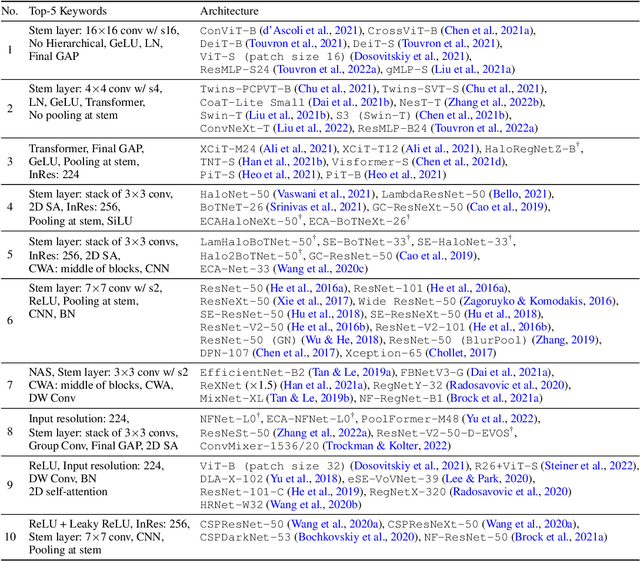
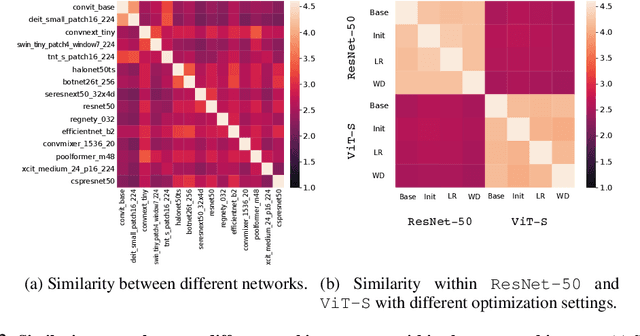
Abstract:In this paper, we aim to design a quantitative similarity function between two neural architectures. Specifically, we define a model similarity using input gradient transferability. We generate adversarial samples of two networks and measure the average accuracy of the networks on adversarial samples of each other. If two networks are highly correlated, then the attack transferability will be high, resulting in high similarity. Using the similarity score, we investigate two topics: (1) Which network component contributes to the model diversity? (2) How does model diversity affect practical scenarios? We answer the first question by providing feature importance analysis and clustering analysis. The second question is validated by two different scenarios: model ensemble and knowledge distillation. Our findings show that model diversity takes a key role when interacting with different neural architectures. For example, we found that more diversity leads to better ensemble performance. We also observe that the relationship between teacher and student networks and distillation performance depends on the choice of the base architecture of the teacher and student networks. We expect our analysis tool helps a high-level understanding of differences between various neural architectures as well as practical guidance when using multiple architectures.
Curved Representation Space of Vision Transformers
Oct 11, 2022


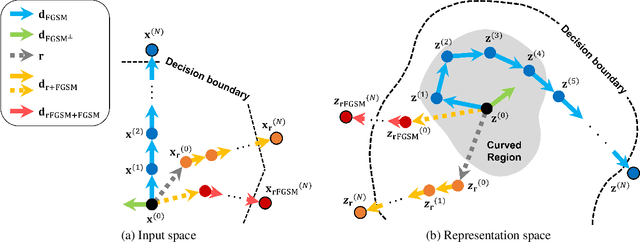
Abstract:Neural networks with self-attention (a.k.a. Transformers) like ViT and Swin have emerged as a better alternative to traditional convolutional neural networks (CNNs) for computer vision tasks. However, our understanding of how the new architecture works is still limited. In this paper, we focus on the phenomenon that Transformers show higher robustness against corruptions than CNNs, while not being overconfident (in fact, we find Transformers are actually underconfident). This is contrary to the intuition that robustness increases with confidence. We resolve this contradiction by investigating how the output of the penultimate layer moves in the representation space as the input data moves within a small area. In particular, we show the following. (1) While CNNs exhibit fairly linear relationship between the input and output movements, Transformers show nonlinear relationship for some data. For those data, the output of Transformers moves in a curved trajectory as the input moves linearly. (2) When a data is located in a curved region, it is hard to move it out of the decision region since the output moves along a curved trajectory instead of a straight line to the decision boundary, resulting in high robustness of Transformers. (3) If a data is slightly modified to jump out of the curved region, the movements afterwards become linear and the output goes to the decision boundary directly. Thus, Transformers can be attacked easily after a small random jump and the perturbation in the final attacked data remains imperceptible, i.e., there does exist a decision boundary near the data. This also explains the underconfident prediction of Transformers. (4) The curved regions in the representation space start to form at an early training stage and grow throughout the training course. Some data are trapped in the regions, obstructing Transformers from reducing the training loss.
 Add to Chrome
Add to Chrome Add to Firefox
Add to Firefox Add to Edge
Add to Edge